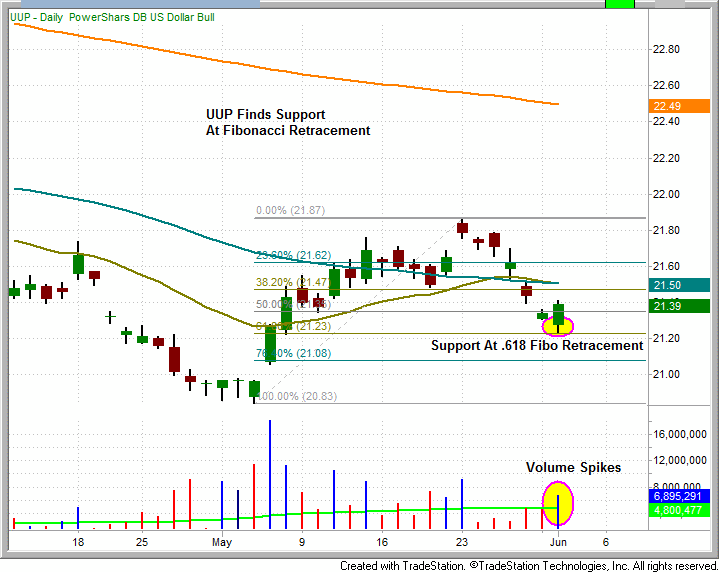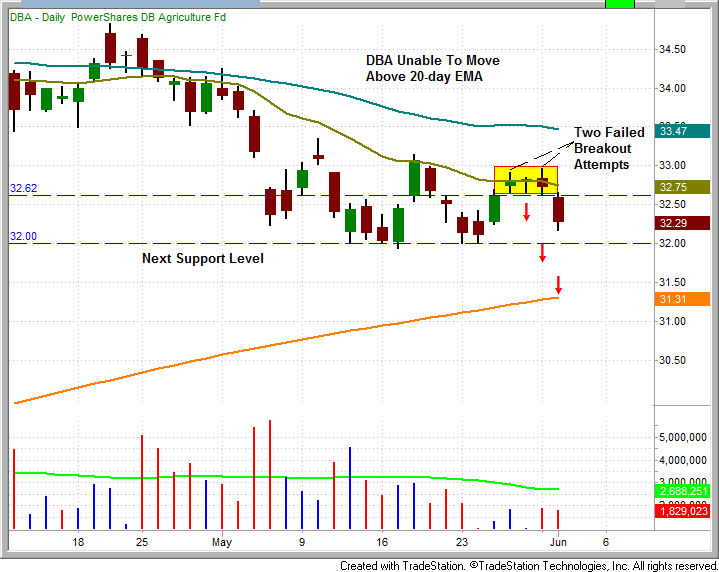| The Wagner Daily ETF Report For June 2 |
| By Deron Wagner |
Published
06/2/2011
|
Stocks
|
Unrated
|
|
|
|
The Wagner Daily ETF Report For June 2
In a dramatic reversal of Tuesday's action, equities got pummeled yesterday on significant but mixed volume. Stocks were under selling pressure for the entire day and closed near session lows. All five major indices closed down more than 2% in a broad based selloff. Yesterday's distribution marked the biggest loss for the S&P 500 since August 2010. The small-cap Russell 2000 led the decline as it shed 3.2% by the close. The S&P MidCap 400 gave back 2.5% while the Dow Jones Industrial Average, S&P 500 and the Nasdaq all tanked 2.3%. It is noteworthy that the Dow Jones Transportation Index not only dropped more than 3.0% but also closed below a key support level at 5,311.
Market internals were mixed but it would be difficult to suggest that there was anything but broad based selling yesterday. At a minimum we would have to classify Wednesday's action as a distribution day for the broad market (NYSE) even if we couldn't technically claim a distribution day for the Nasdaq. Volume ended the day almost 3% higher on the NYSE but fell 7.6% on the Nasdaq. However, declining volume overwhelmed advancing volume by a ratio of 20 to 1 on the NYSE and 10 to 1 on the Nasdaq. We have not seen the spread ratio at such an extreme on the NYSE since August 2010 and on the Nasdaq since February of this year. These ratios make a definitive argument for broad based selling. Despite the fact that volume ended the session mixed, it was apparent from the absolute level of volume and the breadth of the selling that institutions were actively participating in the decline. Therefore we would consider yesterday to be both a reversal day and a distribution day. Based on our research of such reversals we have found that there is less than a 30% chance that Tuesday's rally represents the intermediate trend. It is much more likely that Wednesday's (yesterday's) move has set the tone for continued weakness in the market. Today's decline likely marked the start of an intermediate trend reversal. We must still wait for the market to confirm this opinion but our bias is now with the bears and caution is advised on the long side of the market.
Given yesterday's wild price action, we thought it might be useful to review our recent short trade in IWM as a learning experience. During Tuesday's sharp rally we were barely stopped out of our remaining 1/3rd position in IWM. Yesterday (Wednesday), IWM reversed dramatically and would have brought us back to breakeven in that portion of the trade. Several important lessons can be gleaned from this trade. First, taking profits is a good thing. That's why we exited 2/3rds of the position as it approached support and only held onto 1/3rd of the trade. Second, in hindsight it would have made sense to move our protective stop to breakeven on the final portion of this trade. Third, never second guess a trade. We set a stop, the stop was hit and the trade was exited. Never carry regret about exiting a position. To do otherwise will only result in disaster in the long run as it often leads to poor trading habits such as revenge trading or ignoring stops. As of the close on Tuesday there was no reason to believe that the market was going to crumble as it did yesterday. However we did point out in yesterday's newsletter that there was ample reason to believe that the market might pull back. We stated, "With yesterday's (Tuesday's) sharp price move (rally) in the market, several of our short term momentum indicators suggest the market may be close to an overbought state. Consequently we are not inclined to enter new long positions as we do not consider it prudent to chase the market. Should the market be posturing to set new highs, we prefer to wait for a pullback followed by consolidation to enter new long positions". For anyone to suggest that they could have predicted the breadth of Wednesday's dramatic reversal would be nothing short of speculation and fabrication. As a side note, we are still short GDX as it did not hit its stop. The verdict is still out as to whether or not GDX will reach its profit target. The point is that in trading, the knife cuts both ways. This leads to the third point. When the market reverses after you have been stopped out of a trade (in this case a partial short position in IWM), you cannot be afraid to reenter that position or enter other similar trades based on the information the market is providing. That is precisely why we shorted DBA and went long UUP via intraday alerts yesterday. The previous trade should not influence subsequent trades. Each trade stands on its own merits. Further, we did not allow the bullishness of Tuesday's session to cloud the message the market was providing yesterday. We do not yet know if these new positions will be profitable, but for the moment they are in our favor. The fourth lesson is that major day over day swings are generally unpredictable and what you think you are seeing in the market is sometimes quite different from reality. Based on our technical trading methodology we reasonably classified Tuesday as an accumulation day. But in retrospect what we likely witnessed on Tuesday was selling into strength...with the strength probably coming as a result of short covering and not institutional buying. It is important to understand that it only takes a small move in price to elicit a big reaction if the market is loaded on the long or short side. The suspected short squeeze may have evolved as follows: The market gapped up on Tuesday thus trapping the shorts. We then saw a significant selloff which served to attract more shorts (greed kicked in). The market then moved methodically higher and when the market didn't sell off into the close the shorts had to cover. Consequently, modest late day buying could have fueled a short squeeze. The fifth and final lesson is that potential trend reversals (if we are in fact in a trend reversal) come as a result of the unexpected. That is why it is important to treat Wednesday's reversal seriously as moves like this do not occur very often. Until yesterday, a selloff of this magnitude had not occurred in the S&P 500 since August 2010. Moves like the one we saw yesterday are an undeniable signal. Therefore when they do occur it is important to openly accept (don't fight) what is happening and either get out of the market or adjust your thinking accordingly. We hope this commentary was insightful!
Yesterday we entered a long position in the PowerShares DB US Dollar Bull ETF (UUP) via intraday alter. We decided to enter the trade because UUP found support at a .618 Fibonacci retracement level, undercut Tuesday's low, formed a reversal candle, rallied back above Tuesday's high and closed near session highs on a spike in volume. Trade details are available to our subscribing members in the open positions segment of the newsletter.

We also entered a short position in the PowerShares DB Agricultural ETF (DBA) yesterday. We liked this trade because DBA had consolidated at its 20-day EMA for three days but failed to close above this key mark as the market was moving higher. Further, DBA formed a reversal candle on Tuesday and had two failed breakout attempts in three days. We set a trigger near the three-day low. The inverse ETFs that exist for agriculture/commodities trade very light volume and therefore don't meet our trading criteria.

Given the severity of yesterday's selloff we would not be surprised to see some type of "relief rally" or modest gap up at the open today. Should we encounter this type of price action we will likely use it as an opportunity to enter additional short positions. If we gap down and/or sell off sharply we will probably look to take profits.
Deron Wagner is the Founder and Head Trader of both Morpheus Capital LP, a U.S. hedge fund, and MorpheusTrading.com, a trader education firm.
|